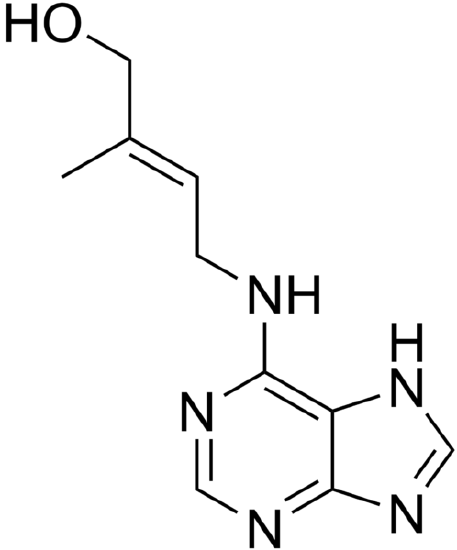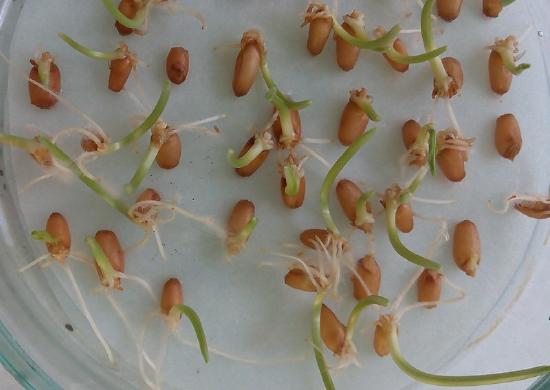4.4.2: Cytokinins
- Page ID
- 32026
Learning Objective
Identify the locations of synthesis, transport, and actions of cytokinins.
Cytokinins are plant hormones that promote cytokinesis (cell division) are derivatives of the purine adenine. (They are not to be confused with cytokines.) The effect of cytokinins was first reported when it was found that adding the liquid endosperm of coconuts to developing plant embryos in culture stimulated their growth. Without the cytokinins from the endosperm, plant cells would not divide by mitosis. Almost 200 naturally occurring or synthetic cytokinins are known to date. Zeatin is an example of naturally occurring cytokinin (Figure \(\PageIndex{1}\)), and kinetin is an example of a synthetic cytokinin.

Cytokinins are synthesized in roots tips and other young structures where cell division is occurring such as embryos and fruits. They are also produced by wounded tissue. Cytokinins are transported through the xylem.
Actions of Cytokinins
One of the clearest examples of cytokinin stimulating cell division involves seed germination. The endosperm of monocot seeds, such as corn (maize), contains large stores of the precursor to the cytokinin zeatin. When the corn kernel germinates, zeatin moves from the endosperm to the root tip where it stimulates vigorous mitosis (Figure \(\PageIndex{2}\)).

Plant development is controlled by multiple hormones working together or balancing each other's effects. Cytokinins play an important role in plant development. They are involved in leaf formation, and they delay senescence in leaf tissues. Cytokinins also play a role in chloroplast development.
Cytokinins often counter the effects of auxin when regulating shoot and root development. Cytokinins inhibit apical dominance by stimulating axillary bud development, having the opposite effect as auxin. They inhibit the formation of lateral roots while auxin initiates lateral roots. When cytokinins are applied to a callus (mass of undifferentiated cells), shoots form. If auxin is applied, roots form. If the two hormones are applied in equal amounts, much the rate of cell division increases, but the callus does not produce distinct shoots and roots.
With respect to mediating roots gravitropism, however, the effect of cytokinin is similar to that of auxin. When a root is turned on its side, cytokinins accumulate on the lower side, inhibiting elongation there. As the upper surface of the root elongates, it bends downwards.
Mechanism of Cytokinin Action
Like auxins, cytokinin can cause changes in gene expression. To begin this process, a cytokinin binds to a receptor protein embedded in the plasma membrane of the cell. The internal portion of the receptor then attaches a phosphate group to a protein in the cytosol. This protein moves into the nucleus where it activates one or more nuclear transcription factors, which then bind to the promoters of genes. Transcription of these genes produces mRNAs that move out into the cytosol. Translation of these mRNAs produces the proteins that enable the cell to carry out its cytokine-induced function.
Attributions
Curated and authored by Melissa Ha from the following sources:
- 30.6 Plant Sensory Systems and Responses from Biology 2e by OpenStax (licensed CC-BY). Access for free at openstax.org.
- 16.5C Cytokinins from Biology by John. W. Kimball (licensed CC-BY)
- Plant Hormones and Sensory Systems by Biology 1520 Introduction to Organismal Biology (licensed CC BY-NC-SA)


